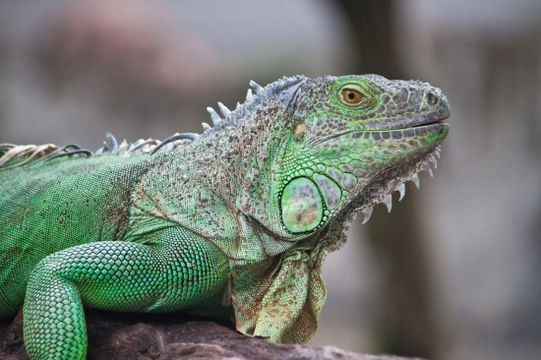
Keeping Green Iguanas Successfully
The green iguana (Iguana iguana), or ‘iggie’ for short, has not always had the best reputation in the reptile hobby, due largely to the health and behavioural problems that the vast numbers of wild-caught and captive-farmed youngsters available cheaply in the 1980s experienced as a result of our own poor understanding of their environmental and dietary requirements at the time. Now however, these attractive and imposing lizards can enjoy a much more informed and species-specific level of care, and so make enjoyable and engaging pets when provided with suitable housing and a sound understanding of their behaviour and habits. That said, because they are so large and have the potential to inflict fairly serious bites and scratches if mishandled, they are best left to experienced keepers and are not recommended for novices.
Originating from the tropical rainforest habitats of south America and the Caribbean, the green iguana is one of the largest members of the iguanidae family of lizards, which also includes the anoles, swifts and leopard lizards. They are primarily shades of green in colour with black bands along the length of the tail, and many hatchlings often start out life a vibrant shade of emerald green that fades to shades of olive in mature animals. They are a sexually dimorphic species, meaning that mature adult specimens can be sexed based on appearance alone. Males are typically much larger than females with a much more pronounced crest of dorsal spines running along the backbone and a large, pendulous dewlap – a large flap of skin beneath the chin – which is used in territorial and dominance displays of head shaking and bobbing. Sexually mature males may also change in colour and develop shades of yellow or orange on their legs and flanks. Female have less robust features than males and smaller, more pointed heads and smaller dorsal spines. Some females may develop pale shades of blue or orange on their bodies during the breeding season.
These diurnal (day-time active) lizards can quickly grow from cute 12 inch long hatchlings into dinosaur-like 5-6 foot long adults, and like other large reptiles will need a large, custom-built enclosure with plenty of height to allow for their arboreal climbing and basking habits while providing enough floor space for a large pool for drinking and bathing – a minimum size for a large adult male would be no less than 8 foot tall x 6 foot wide x 4 foot deep, with bigger always being better in these cases - as with large monitor lizards, most keepers will opt to build their iguana enclosures themselves and should expect to spend a considerable amount of money in doing so, and specially modified wooden garden sheds can be useful in providing a basis for building an iguana house. This needs to be furnished with several sturdy branches and platforms for sleeping, feeding and basking, with high wattage combined mercury vapour bulbs now being the preferred choice for providing both the heat they require for thermoregulation and the full spectrum UV lighting essential for correct vitamin D and calcium synthesis. An iguana enclosure does not need to be extensively decorated although some keepers may choose to paint an attractive rainforest -type background or add plastic and silk plants to create a more naturalistic environment, although care should be taken to make sure the occupant does not mistake these for the real thing and try to ingest them. Bark chippings can be used as a natural-looking substrate if required and are good for retaining humidity, although plastic turf has the advantage of being easy to remove and wash if it becomes soiled. Newspaper is also a great alternative, being cheap and easy to take out and replace during cleaning.
Iguanas are strict herbivores, and the cost of twice-weekly trips to the supermarket in order to provide a varied and balanced diet of fresh vegetables, salad leaves and fruit, plus the use of vitamin and mineral supplements, should be a major consideration in whether a reptile keeper can commit to keeping a lizard of this type. Mustard and collard greens, endive and watercress should form the bulk of the diet, with spinach, cabbage, kale, pak choi and treat such as soft fruits added in for variety. The key to maintaining a complete herbivorous diet is finding a balance of nutrients, with careful management of calcium and potassium levels in particular.
Regular handling of young iguanas is crucial to accustom them to human interaction and minimise the risk of injury to handlers once they reach full size. Babies are often very flighty and will struggle if not held gently but securely, but will quickly tame down if offered tempting treats such as small pieces of apple when being held. This creates a positive reinforcement and encourages them to develop a positive association with humans, making them calmer and easier to manage as adults. However sexually mature males in particular are notorious for becoming hormonal and aggressive during the breeding season, when their territorial behaviours and desire to dominate those around them are at their peak. A pair of thick gloves and an old towel should be kept handy in which to wrap up and help restrain particularly stroppy males during this time should they become particularly unmanageable when out of their vivarium.
Despite being cheaply and easily available back in the early days of the reptile hobby, green iguanas are rarely bred as pets now and thankfully so, as the temptation of novice keepers to buy a tiny cute hatchling for as little as £30 in unscrupulous pet shops inevitably leads to problems for both human and lizard later on. As a result, experienced keepers wanting to take on one of these large reptiles are encouraged to contact one of the many reptile rescue organisations that take in unwanted or abandoned animals, as such rescue centres are often full of juvenile or adult iguanas in desperate need of experienced and loving homes.



